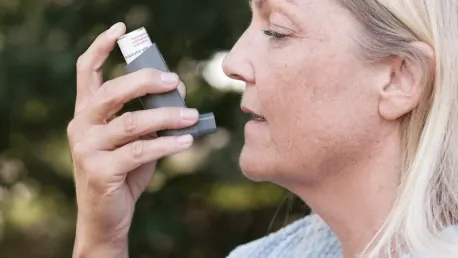Chronic obstructive pulmonary disease (COPD) is a progressive respiratory condition that profoundly impacts patients’ quality of life and incurs substantial healthcare costs. Effective management of COPD often necessitates the use of inhaled medications, such as corticosteroids, long-acting beta-agonists, and long-acting muscarinic antagonists. Recently, researchers from the United States and Canada conducted a study to compare the effectiveness and safety of two single-inhaler triple therapies: budesonide-glycopyrrolate-formoterol and fluticasone-umeclidinium-vilanterol. Their findings, published in the BMJ, provide essential insights into whether fluticasone-umeclidinium-vilanterol offers a clinical advantage over budesonide-glycopyrrolate-formoterol in managing COPD. This article delves into the significant results of the study and explores its implications for COPD treatment.
Understanding COPD and Its Treatment
COPD is marked by persistent airflow limitations and frequent exacerbations, leading to recurring hospitalizations and worsening of overall health. The primary objective in treating COPD is to alleviate symptoms and prevent exacerbations using inhaled corticosteroids, long-acting beta-agonists, and long-acting muscarinic antagonists. Triple inhaler therapy combines these medications into a single inhaler for greater convenience and better adherence among patients. However, while the individual components of triple therapy have shown benefits in randomized trials, there has been limited direct comparison of different formulations of these combinations. Moreover, the growing concerns regarding the environmental impact of metered-dose inhalers have underscored the necessity to evaluate alternative options such as dry powder inhalers.
Triple inhaler therapy has proven effective in managing COPD, but the lack of direct comparison between differing formulations has left clinicians in need of more specific information. Fluticasone-umeclidinium-vilanterol, a dry powder inhaler, and budesonide-glycopyrrolate-formoterol, a metered-dose inhaler, have both shown promise in managing COPD. Evaluating which of these inhaler therapies offers superior clinical outcomes while also considering environmental sustainability is important for guiding treatment choices. This study sought to fill this gap by analyzing real-world data to discern the effectiveness and safety of these inhaler formulations.
Study Overview and Methodology
The study analyzed data from the United States health claims between 2021 and 2023, focusing on individuals aged 40 years and older who were newly diagnosed with COPD and were new users of either budesonide-glycopyrrolate-formoterol or fluticasone-umeclidinium-vilanterol. Researchers excluded patients with previous exposure to triple therapy, concurrent use of other inhalers, or incomplete baseline data to ensure the accuracy of the findings.
Key outcomes of the study included the frequency of moderate or severe COPD exacerbations and the rate of hospitalization due to pneumonia. Moderate exacerbations were identified by short courses of systemic steroids, while severe exacerbations required hospitalizations. Pneumonia-related hospital admissions were determined through diagnostic codes. Patients were followed for up to one year or until the treatment was discontinued, switched, or an outcome occurred. This robust methodology aimed to provide comprehensive and reliable real-world evidence to guide clinical decisions.
Effectiveness in Reducing Exacerbations
The study found that fluticasone-umeclidinium-vilanterol therapy resulted in fewer exacerbations compared to budesonide-glycopyrrolate-formoterol. Specifically, among the 20,388 matched pairs, moderate or severe exacerbations were 9% higher among budesonide-glycopyrrolate-formoterol users. Within this group, moderate exacerbations increased by 7%, while severe exacerbations rose by a significant 29%.
These findings suggest that fluticasone-umeclidinium-vilanterol may offer a slight clinical advantage in reducing the frequency and severity of COPD exacerbations. This is particularly important for patients who experience frequent exacerbations, as reducing these events can significantly improve their quality of life and reduce healthcare costs. By minimizing exacerbations, fluticasone-umeclidinium-vilanterol therapy may not only enhance patient well-being but also provide economic benefits through decreased hospital visits and medical interventions.
Safety Concerns: Pneumonia Hospitalizations
One of the primary safety concerns with inhaled corticosteroids is the risk of pneumonia, a potentially severe complication for COPD patients. The study revealed that hospitalization rates for pneumonia were identical between the two therapies, indicating no increased risk of pneumonia with either inhaler therapy. This finding is particularly reassuring for clinicians and patients, as it suggests that both therapies are equally safe concerning pneumonia risk.
This equality in pneumonia risk underscores the importance of choosing the optimal therapy based on exacerbation reduction rather than potential side effects alone. The absence of increased pneumonia risk with fluticasone-umeclidinium-vilanterol further solidifies its slight clinical advantage over budesonide-glycopyrrolate-formoterol. Clinicians can recommend fluticasone-umeclidinium-vilanterol with greater confidence, knowing that it does not compromise patient safety while offering superior management of COPD exacerbations.
Subgroup Analysis and Patient-Specific Factors
The study also conducted a subgroup analysis to explore the effectiveness and safety of the two therapies in different patient populations. Results showed that patients with prior exacerbations, severe disease, or higher eosinophil counts experienced higher risks with budesonide-glycopyrrolate-formoterol. Conversely, the differences were less pronounced in patients without these risk factors, suggesting that patient-specific characteristics significantly influence therapy outcomes.
These findings highlight the necessity for personalized treatment plans for COPD patients. Clinicians should consider individual patient characteristics such as prior exacerbations and disease severity to determine the most suitable inhaler therapy. Tailoring treatment to the specific needs and risk factors of each patient can enhance therapeutic outcomes and ensure patients receive the most effective and safe management for their condition. Personalized care approaches may also improve adherence and satisfaction, further boosting the overall success of COPD management.
Environmental Considerations
The environmental impact of inhaler formulations is an important consideration in the context of global healthcare efforts to reduce environmental footprints. Metered-dose inhalers have been associated with higher greenhouse gas emissions compared to dry powder inhalers. This study’s confirmation of the clinical effectiveness of dry powder inhalers like fluticasone-umeclidinium-vilanterol over metered-dose inhalers holds significance for environmental sustainability.
By promoting the use of dry powder inhalers, healthcare providers can contribute to reducing the ecological footprint of COPD treatment while maintaining high standards of patient care. This aligns with broader efforts to adopt sustainable medical practices and mitigate climate change. The dual benefit of clinical efficacy and environmental responsibility makes fluticasone-umeclidinium-vilanterol a preferable choice in the evolving landscape of COPD therapy.
Consistent Mortality Rates and Sensitivity Analyses
Sensitivity analyses involving variable follow-up times and different exacerbation definitions corroborated the main findings of the study. Both inhaler therapies were found to have similar all-cause mortality rates, ensuring that the observed differences in exacerbations and pneumonia were not offset by heightened mortality risks. This consistency reinforces the study’s overall conclusions and provides greater confidence in the recommendations for clinical practice.
In summary, the research indicated no clinical advantage of budesonide-glycopyrrolate-formoterol over fluticasone-umeclidinium-vilanterol in terms of managing COPD exacerbations and pneumonia hospitalizations. Fluticasone-umeclidinium-vilanterol demonstrated a slight clinical edge by reducing COPD exacerbations while maintaining equivalent safety concerning pneumonia risk compared to its counterpart. Additionally, the findings aligned with environmental health goals, advocating for the use of dry powder inhalers over metered-dose inhalers. This comprehensive evidence base enables clinicians to make informed decisions about prescribing triple inhaler therapies for COPD patients, considering both clinical efficacy and environmental impact.









